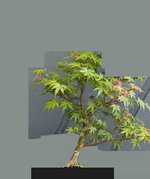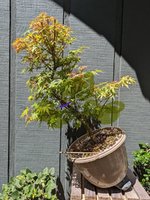IllinoisSam
Sapling
This J. maple is from Brussel's. The base of the trunk is about 3/4" in diameter and the distance from the soil to the first bend is about 6". I'm trying to imagine what to do with this thing. It's in the usual bonsai nursery S shape and I'm not fond of how straight the bottom of the trunk is. I've only had it for a couple of weeks, so the only thing I've done so far is to slip pot it and start fertilizing it. I was thinking about air or ground layering it to put the first bend closer to the soil.
I guess if I tilted it and pulled the top of the "S" down it might look more interesting. What do you think?
Thanks.


I guess if I tilted it and pulled the top of the "S" down it might look more interesting. What do you think?
Thanks.






